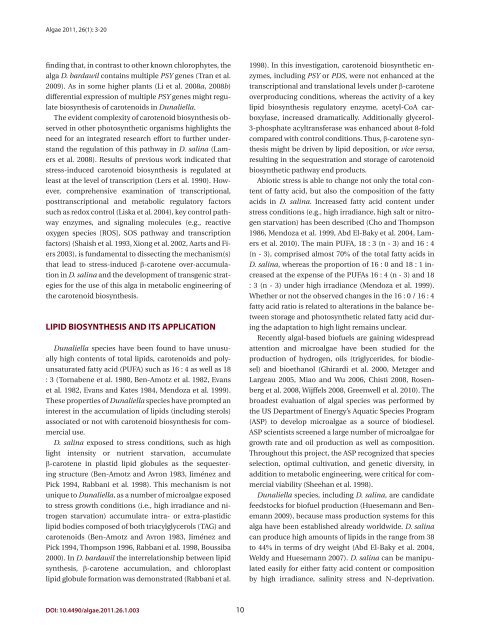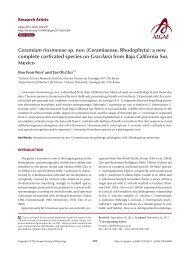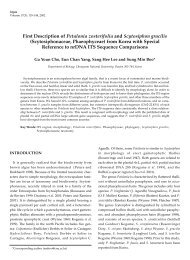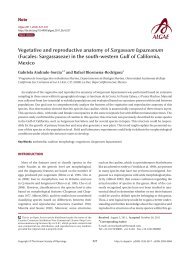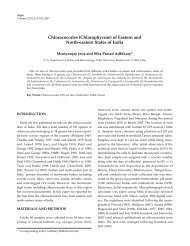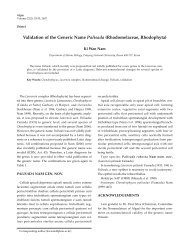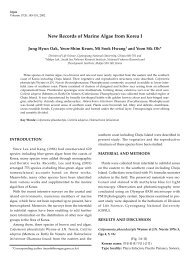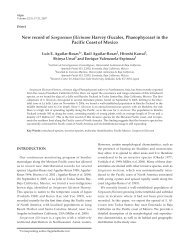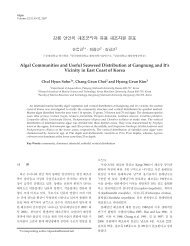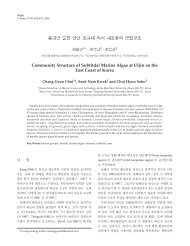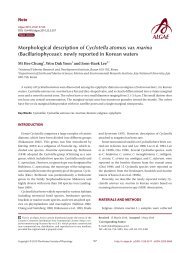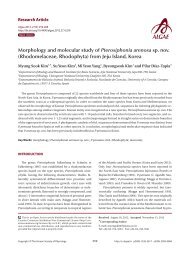The unicellular green alga Dunaliella salina Teod. as a model - Algae
The unicellular green alga Dunaliella salina Teod. as a model - Algae
The unicellular green alga Dunaliella salina Teod. as a model - Algae
Create successful ePaper yourself
Turn your PDF publications into a flip-book with our unique Google optimized e-Paper software.
<strong>Algae</strong> 2011, 26(1): 3-20<br />
finding that, in contr<strong>as</strong>t to other known chlorophytes, the<br />
<strong>alga</strong> D. bardawil contains multiple PSY genes (Tran et al.<br />
2009). As in some higher plants (Li et al. 2008a, 2008b)<br />
differential expression of multiple PSY genes might regulate<br />
biosynthesis of carotenoids in <strong>Dunaliella</strong>.<br />
<strong>The</strong> evident complexity of carotenoid biosynthesis observed<br />
in other photosynthetic organisms highlights the<br />
need for an integrated research effort to further understand<br />
the regulation of this pathway in D. <strong>salina</strong> (Lamers<br />
et al. 2008). Results of previous work indicated that<br />
stress-induced carotenoid biosynthesis is regulated at<br />
le<strong>as</strong>t at the level of transcription (Lers et al. 1990). However,<br />
comprehensive examination of transcriptional,<br />
posttranscriptional and metabolic regulatory factors<br />
such <strong>as</strong> redox control (Liska et al. 2004), key control pathway<br />
enzymes, and signaling molecules (e.g., reactive<br />
oxygen species [ROS], SOS pathway and transcription<br />
factors) (Shaish et al. 1993, Xiong et al. 2002, Aarts and Fiers<br />
2003), is fundamental to dissecting the mechanism(s)<br />
that lead to stress-induced β-carotene over-accumulation<br />
in D. <strong>salina</strong> and the development of transgenic strategies<br />
for the use of this <strong>alga</strong> in metabolic engineering of<br />
the carotenoid biosynthesis.<br />
LIPID BIOSYNTHESIS AND ITS APPLICATION<br />
<strong>Dunaliella</strong> species have been found to have unusually<br />
high contents of total lipids, carotenoids and polyunsaturated<br />
fatty acid (PUFA) such <strong>as</strong> 16 : 4 <strong>as</strong> well <strong>as</strong> 18<br />
: 3 (Tornabene et al. 1980, Ben-Amotz et al. 1982, Evans<br />
et al. 1982, Evans and Kates 1984, Mendoza et al. 1999).<br />
<strong>The</strong>se properties of <strong>Dunaliella</strong> species have prompted an<br />
interest in the accumulation of lipids (including sterols)<br />
<strong>as</strong>sociated or not with carotenoid biosynthesis for commercial<br />
use.<br />
D. <strong>salina</strong> exposed to stress conditions, such <strong>as</strong> high<br />
light intensity or nutrient starvation, accumulate<br />
β-carotene in pl<strong>as</strong>tid lipid globules <strong>as</strong> the sequestering<br />
structure (Ben-Amotz and Avron 1983, Jiménez and<br />
Pick 1994, Rabbani et al. 1998). This mechanism is not<br />
unique to <strong>Dunaliella</strong>, <strong>as</strong> a number of micro<strong>alga</strong>e exposed<br />
to stress growth conditions (i.e., high irradiance and nitrogen<br />
starvation) accumulate intra- or extra-pl<strong>as</strong>tidic<br />
lipid bodies composed of both triacylglycerols (TAG) and<br />
carotenoids (Ben-Amotz and Avron 1983, Jiménez and<br />
Pick 1994, Thompson 1996, Rabbani et al. 1998, Boussiba<br />
2000). In D. bardawil the interrelationship between lipid<br />
synthesis, β-carotene accumulation, and chloropl<strong>as</strong>t<br />
lipid globule formation w<strong>as</strong> demonstrated (Rabbani et al.<br />
DOI: 10.4490/<strong>alga</strong>e.2011.26.1.003 10<br />
1998). In this investigation, carotenoid biosynthetic enzymes,<br />
including PSY or PDS, were not enhanced at the<br />
transcriptional and translational levels under β-carotene<br />
overproducing conditions, where<strong>as</strong> the activity of a key<br />
lipid biosynthesis regulatory enzyme, acetyl-CoA carboxyl<strong>as</strong>e,<br />
incre<strong>as</strong>ed dramatically. Additionally glycerol-<br />
3-phosphate acyltransfer<strong>as</strong>e w<strong>as</strong> enhanced about 8-fold<br />
compared with control conditions. Thus, β-carotene synthesis<br />
might be driven by lipid deposition, or vice versa,<br />
resulting in the sequestration and storage of carotenoid<br />
biosynthetic pathway end products.<br />
Abiotic stress is able to change not only the total content<br />
of fatty acid, but also the composition of the fatty<br />
acids in D. <strong>salina</strong>. Incre<strong>as</strong>ed fatty acid content under<br />
stress conditions (e.g., high irradiance, high salt or nitrogen<br />
starvation) h<strong>as</strong> been described (Cho and Thompson<br />
1986, Mendoza et al. 1999, Abd El-Baky et al. 2004, Lamers<br />
et al. 2010). <strong>The</strong> main PUFA, 18 : 3 (n - 3) and 16 : 4<br />
(n - 3), comprised almost 70% of the total fatty acids in<br />
D. <strong>salina</strong>, where<strong>as</strong> the proportion of 16 : 0 and 18 : 1 incre<strong>as</strong>ed<br />
at the expense of the PUFAs 16 : 4 (n - 3) and 18<br />
: 3 (n - 3) under high irradiance (Mendoza et al. 1999).<br />
Whether or not the observed changes in the 16 : 0 / 16 : 4<br />
fatty acid ratio is related to alterations in the balance between<br />
storage and photosynthetic related fatty acid during<br />
the adaptation to high light remains unclear.<br />
Recently <strong>alga</strong>l-b<strong>as</strong>ed biofuels are gaining widespread<br />
attention and micro<strong>alga</strong>e have been studied for the<br />
production of hydrogen, oils (triglycerides, for biodiesel)<br />
and bioethanol (Ghirardi et al. 2000, Metzger and<br />
Largeau 2005, Miao and Wu 2006, Chisti 2008, Rosenberg<br />
et al. 2008, Wijffels 2008, Greenwell et al. 2010). <strong>The</strong><br />
broadest evaluation of <strong>alga</strong>l species w<strong>as</strong> performed by<br />
the US Department of Energy’s Aquatic Species Program<br />
(ASP) to develop micro<strong>alga</strong>e <strong>as</strong> a source of biodiesel.<br />
ASP scientists screened a large number of micro<strong>alga</strong>e for<br />
growth rate and oil production <strong>as</strong> well <strong>as</strong> composition.<br />
Throughout this project, the ASP recognized that species<br />
selection, optimal cultivation, and genetic diversity, in<br />
addition to metabolic engineering, were critical for commercial<br />
viability (Sheehan et al. 1998).<br />
<strong>Dunaliella</strong> species, including D. <strong>salina</strong>, are candidate<br />
feedstocks for biofuel production (Huesemann and Benemann<br />
2009), because m<strong>as</strong>s production systems for this<br />
<strong>alga</strong> have been established already worldwide. D. <strong>salina</strong><br />
can produce high amounts of lipids in the range from 38<br />
to 44% in terms of dry weight (Abd El-Baky et al. 2004,<br />
Weldy and Huesemann 2007). D. <strong>salina</strong> can be manipulated<br />
e<strong>as</strong>ily for either fatty acid content or composition<br />
by high irradiance, salinity stress and N-deprivation.


